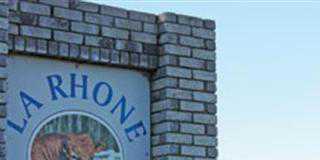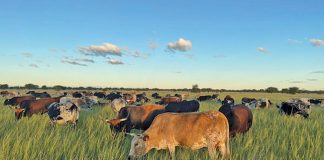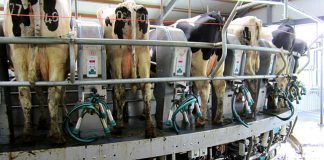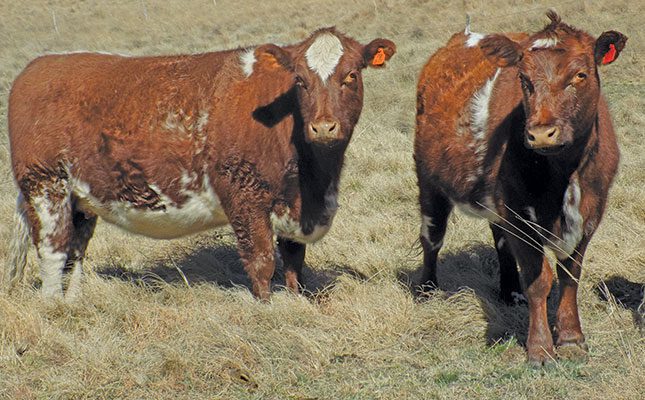
Photo: Annelie Coleman
According to Barry Stretton, the Beef Shorthorn is without question the right breed to meet the demands of commercial cattlemen in the ever-changing economy of beef production.
This is evident in the growing popularity of the breed since it fell out of favour in the 1990s because of the domination of the beef cattle arena by continental and composite breeds.
READ What to consider when mixing your own feed
“I believe the resurgence in the popularity of the Beef Shorthorn is driven by market demands for first-class quality beef coupled with low inputs. Known for its incomparable maternal traits, top fertility, ease of calving, premium milk production and even temperament, among others, the breed adheres to virtually all the money-making traits sought after by commercial producers,” says Stretton.
Universal improver
The Shorthorn was developed during the last quarter of the 18th century through selective breeding of local cattle of the Teeswater district, Durham County, in the north of England.
It was characterised by short horns, blocky conformation, and colour ranging from red, red with white markings, white, or roan, resulting from a mixture of red and white.
According to Stretton, the Beef Shorthorn is known as the universal improver and it is one of the most complementary cattle breeds in the world. Beef Shorthorns have contributed to the foundation of 52 composite breeds of cattle.
The breed has had a mammoth influence on the global beef cattle sector, including South Africa, as foundation stock.
Some of the composite breeds include the Bonsmara, Santa Gertrudis and Droughtmaster. Stretton ascribes the worldwide influence of the breed to its multitude of positive attributes, such as exceptional fertility and adaptability, excellent mothering and milk production, as well as its even temperament and calving ease.
The Beef Shorthorn is also free of the myostatin gene, which caused double muscling.
READ Why the ‘right’ breed can earn you more money
Decades of genetics
The Stretton herd is the oldest Beef Shorthorn stud in South Africa and is built on genetics that were finely honed over more than 150 years. The first animals were imported in the 1860s by the King family in Bedford, who established the legendary EF Shorthorn herd.
This was followed by James Burtram Stretton from Molteno who imported Beef Shorthorns in 1904. Barry’s grandfather Henry Stretton, who inherited part of the original Stretton herd, imported a number of Lincoln Red Shorthorns to improve the size of the cattle and formed the Stonebow Lincoln Red Shorthorn stud.
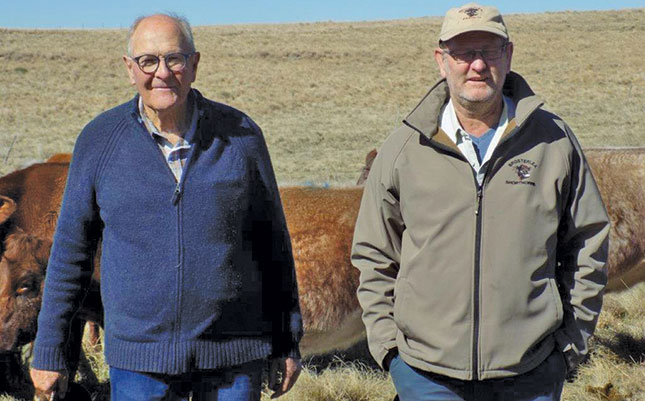
“My father, Jim Stretton, inherited 50% of the Stonebow herd in 1975 and formed the Brotherlea stud. He eventually purchased the original King stud in 1984 and incorporated the animals with the Brotherlea stud.
Fourteen years ago, I took over. The best decision I could have made was undeniably to continue with the Shorthorns. I was fortunate to take over an established herd that is well adapted to our area.
The Brotherlea cattle was selected over generations to adapt in the unforgiving Stormberg area of the Eastern Cape,” says Stretton.
Fashion breeds
According to Stretton, he never was drawn into following, as he put it, the trend of “fashion breeds”, or introducing newly developed composite breeds to his business.
He says he knows now that any such move would definitely not have been an improvement on the purebred Beef Shorthorns of Brotherlea.
The average birthweight of the herd is about 24kg, and any animal presenting with an average birthweight of more than 40kg is culled. The average inter-calving period is 389 days, with a weaning weight of 52% of the dam’s weight.
The ideal Brotherlea cow is medium-framed, early maturing and able to maintain condition on the veld without any additional feeding or pampering. The ideal heifer has strong feminine traits and grows out to 400kg at the age of 24 months for first mating.
In summer a phosphate lick is provided, and a protein lick in winter. Stretton follows a strict high-density, holistic grazing programme.
Coldest place in South Africa
“Molteno is without a doubt the coldest place in South Africa, and temperatures as low as -20°C are not unknown on our farm. A temperature of -21°C was recorded on the farm Buffelsfontein in our vicinity a few years ago. The Beef Shorthorn has over the past 120 years adapted to these harsh conditions of the Stormberg, developing into early-maturing animals that flourish under the most taxing conditions,” says Stretton.
The Brotherlea herd is kept on the Stormberg Plateau semi-sweet veld type, with an average rainfall of 550mm/year. In summer, 30°C is considered a hot day.
Stretton maintains a stocking rate of 1 LSU on 4ha as part of a holistic, high-density veld management system. The veld consists of red grass (Themeda triandra), Robies cocksfoot (Tetrachne dregei) and indigenous Eragrostis species.
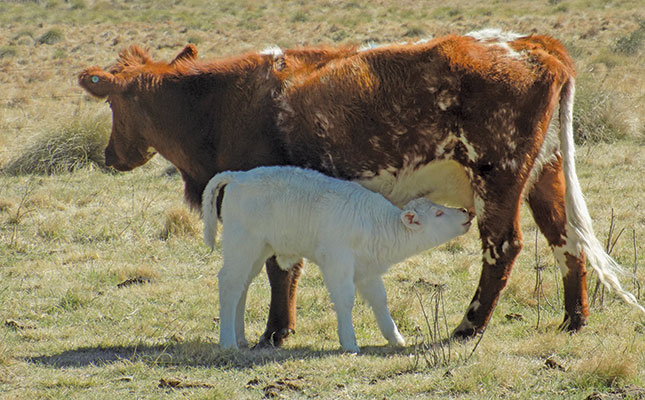
“Our breeding criteria and philosophy are really quite simple: a cow must be able to maintain herself on the veld without extra feed. It is vital for our dams to maintain a good level of condition and take to the bull every year from the age of two years. She must also drop and wean a marketable calf that is at least 48% of her weight at seven months.”
Premium quality
“We are committed to the production and supply of premium-quality breeding animals to the South African red meat producers’ industry. It is very important for us to breed animals that will make a positive contribution to any herd they are introduced to and to afford any beef-breeding concern a solid foundation,” says Stretton, who also serves as president of the South African Beef Shorthorn Breeders’ Society.
Performance testing and recording therefore form a vital part of his management programme. Stretton and Hendrik Strydom, a fellow Beef Shorthorn stud breeder, recently ran the first ever Phase D test on young bulls to determine post-weaning growth and efficiency.
Stretton recently also started performing genomic testing. Parentage is determined through DNA testing and records are kept using the BeefPro system as well as SA Stud Book’s Logix programme.
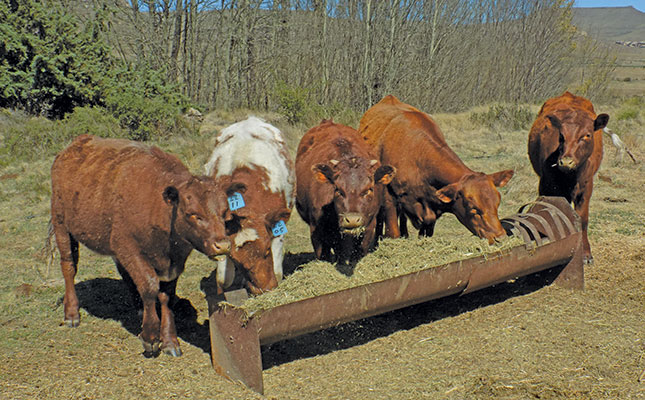
The Stretton herd currently includes 40 cows, 16 replacement heifers and between 18 and 20 bulls. A single-sire breeding programme is followed with the bulls being put to the cows on 1 December for a period 45 days in order for the cows to calve in spring.
The Molteno winters are too harsh for the cows to calve in autumn. Some cows are artificially inseminated (AI) from time to time. The objective is to introduce new genetics that have been sourced locally and internationally into the herd.
Stretton also uses genetics from past Brotherlea sires that have performed well in the AI programme.
“We are fortunate to be farming in a relatively healthy part of the country. The herd is dipped twice a year against lice, and every three months against ticks that carry anaplasmosis. The main diseases in our areainclude three-day stiffness disease, lumpy skin, botulism, quarter evil and anthrax, against which the animals are inoculated as prescribed.”
Stretton says the biggest mistake he made so far was not to take a balanced view upon introducing new genetics to the herd. He so heavily focused on statistics and estimated breeding values that he neglected confirmation, and the stud suffered from this mistake.
This was a most valuable lesson for him and he realised that both aspects needed to be applied equally in selection.
“As a stud breeder,” he says, “I can almost see myself as a custodian of not only the South African Beef Shorthorn breed but also of commercial cattlemen by supplying them with bulls that would actually improve their herds for long-term sustainability and profitability. The genetic integrity of my herd is of utmost importance.”
Email Barry Stretton at [email protected].








